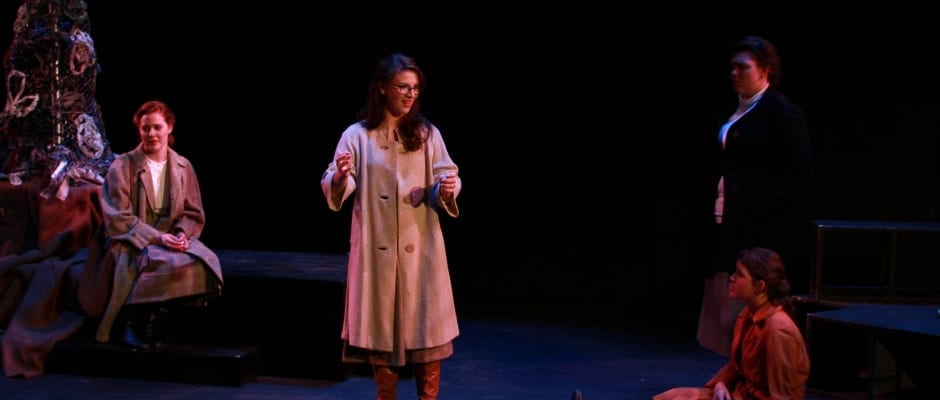
PROVO — Seven years have passed since Pan American Flight 103 exploded 30,000 feet above Lockerbie, Scotland. It may seem like a long time. But for the town of Lockerbie and the families of those lost, it may as well have been but a moment ago. This premise for the story of The Women of Lockerbie, a student-directed production at Brigham Young University, is a heart-wrenching one to say the least. And yet, my hat goes off to the company who created and performed this peace as they were sensitive and respectful in their dealing with a delicate topic.
What I found interesting about this particular presentation of the Pan Am 103 story was the emphasis not on the tragedy itself, but the Lockerbie community response to the Pan Am 103 tragedy, “The Laundry Project.” Historically, “The Laundry Project,” as the program informed me, was the effort of the Lockerbie women to obtain the clothes of the victims, wash them, iron them, gently pack them, and return the clothing in suitcases to the families of the victims–a daunting task completed in the name of love and deserved closure for the families of Pan Am 103 victims.
The playwright, Deborah Brevoort, is to be commended on the intriguing perspective and unique structure of this piece, as it allows the thematic focus to be not on horror, but grief. Brevoort’s play leads us through the journey of a New Jersey couple and three Lockerbie women. The couple is visiting Scotland in hopes to find the remains of their son that were never identified and they end up joining the Lockerbie women in their fight with the U.S. Government to obtain the clothing of deceased passengers aboard Pan Am 103.
First and foremost, credit is due to Jenny Huffman on the success of this piece. In my opinion, it is the director who makes a statement with their work, whether one agrees with said statement or not, that has achieved something worth experiencing. Huffman accomplished portrayal of community, grief, and hope, among other messages. She did this through her stage pictures, use of space, and guided character interractions. By playing with the audience’s space as well as the traditional stage area present, I felt included in the experiences of these characters…as though I was bound to them by simply being nearby, a true definition of community. The pictures created on stage, as well as certain character interractions, displayed the duality of hope and grief by directing my focus and playing with my perception of individual characters’ power in any given moment.
The actors showed a commitment to character and the story that is difficult to achieve. The event was treated with respect and the message was told with absolute dedication. The shining light of powerful performance in the work was Ashley Bonner. Bonner’s portrayal of Olive Allison was dynamic, heartfelt, and moving. She played the motivation of the character with absolute honesty. However, for several of her colleagues I think nuance was lost. Eliot Wood had strong distinctive characterization, which was lovely, but presented an emotional journey for the character that didn’t quite feel organic. At one moment in particular the scene lead to high emotion quite suddenly, even abruptly, when I had no opportunity to understand the character’s journey to that heightened emotion.
What set Bonner’s portrayal apart was primarily in her exploration of strength and happiness through the sadness. In my experience people smile through their tears when grieving; they look toward the hopeful and try not to “burden” others with their torment. They look to find the sunshine in the clouds. I think this could have been further explored; and for me, it would have greatly assisted in the relatability of the piece. That said, the actors had clearly worked to know their characters, understand them, and attempt to feel what their characters were feeling. I simply felt there could have been a greater play with subtlety and all the variant colors of grief, but in no way should this undermine the lovely work that was done.
As far as design of the piece, the technical elements facilitated the work as much as was necessary; they supported the story without overshadowing it. The lighting design by McKell Crandall in particular offered some refreshing visual surprises and beautiful emotional moments. While the symbolism present in the set design by Cameron Bench was catching, there was a need for something more there—as an audience member I sometimes felt lost in a world of black and brown. Some additional specifically chosen contrast in tone would have been nice and heightened Bench’s visual symbolism.
But on the whole, the work was touching. It was gentle, simple, and portrayed what I believe it meant to portray. I send my thanks to BYU and Jenny Huffman for presenting me the opportunity to learn about an experience I would not have learned about otherwise; and to the cast who committed so heartily to the work.
Note: According to BYU Arts, The Women of Lockerbie is not appropriate for audience members under the age of 14.
[box type=”shadow”]The Women of Lockerbie finished its run on December 3 at the Margetts Theater in the Harris Fine Arts Center on the campus of Brigham Young University. Tickets were $6. For more information, visit www.BYUarts.com.[/box]

